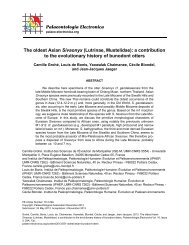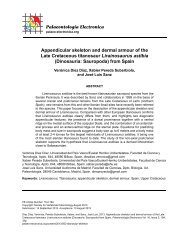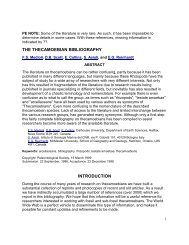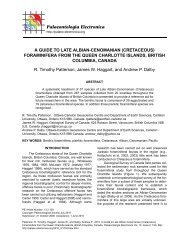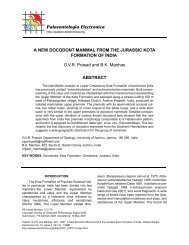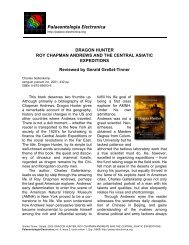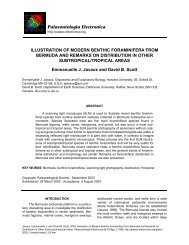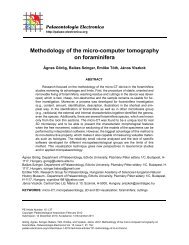Extraction of Calcareous Macrofossils from the Upper Cretaceous
Extraction of Calcareous Macrofossils from the Upper Cretaceous
Extraction of Calcareous Macrofossils from the Upper Cretaceous
You also want an ePaper? Increase the reach of your titles
YUMPU automatically turns print PDFs into web optimized ePapers that Google loves.
NIELSEN AND JAKOBSEN: FOSSILS IN HOT WATER<br />
INTRODUCTION<br />
<strong>Extraction</strong> <strong>of</strong> fossils <strong>from</strong> carbonates is<br />
affected by using different techniques depending<br />
on <strong>the</strong> composition and preservation <strong>of</strong> <strong>the</strong> fossils<br />
and <strong>the</strong> hardness <strong>of</strong> <strong>the</strong> enclosing sediment<br />
(matrix). Preparation consists <strong>of</strong> <strong>the</strong> following<br />
steps: 1) breaking up <strong>the</strong> sample (disaggregation)<br />
by chemical and physical means; 2) removing <strong>the</strong><br />
fine fraction through sieving; 3) drying <strong>the</strong> residue;<br />
and 4) hand-picking <strong>the</strong> fossils. The harder <strong>the</strong><br />
sample is, <strong>the</strong> harsher <strong>the</strong> preparation treatment<br />
required (Green 2001). For uncemented, slightly<br />
consolidated sediments, treatment by wet sieving<br />
is generally sufficient. If <strong>the</strong> fossils are embedded<br />
in more firm sediments, such as chalk, sieving will<br />
be useless without proper pre-treatment. The sample<br />
must be subjected to a procedure <strong>of</strong> disaggregation<br />
(without damaging <strong>the</strong> fossils) prior to wet<br />
sieving. The simplest way <strong>of</strong> disaggregating indurated<br />
calcareous sediments, such as <strong>the</strong> <strong>Upper</strong><br />
<strong>Cretaceous</strong> White Chalk, is by saturating <strong>the</strong> samples<br />
with water and <strong>the</strong>n placing <strong>the</strong>m in a freezer.<br />
The formation <strong>of</strong> ice crystals in <strong>the</strong> pore system<br />
breaks up <strong>the</strong> matrix (Hanna and Church 1928;<br />
Pojeta and Balanc 1989). This freeze-thaw method<br />
can be repeated several times until <strong>the</strong> sediment<br />
(matrix) is fully disaggregated. Ano<strong>the</strong>r freeze-thaw<br />
method is Glauber’s Salt method (Na 2SO 4 10H 2O,<br />
hydrated sodium sulphate) that also requires repetition<br />
<strong>of</strong> <strong>the</strong> procedure to function properly (Surlyk<br />
1972).<br />
The purpose <strong>of</strong> this paper is to document <strong>the</strong><br />
combination <strong>of</strong> two methods that are more efficient<br />
and less time-consuming than freeze-thaw methods<br />
but have received little attention. These are<br />
called <strong>the</strong> acid-hot water method and <strong>the</strong> waterblasting<br />
technique. They have been applied separately<br />
and in combination on samples <strong>from</strong> two<br />
localities: Lower Campanian skeletal sands at Ivö<br />
Klack, Sweden; <strong>the</strong> Maastrichtian White Chalk at<br />
Stevns Chalk Quarry, Denmark; <strong>the</strong> Danian Bryozoan<br />
Limestone at <strong>the</strong> sea cliff Stevns Klint, Denmark;<br />
and <strong>the</strong> Danian Bryozoan Limestone at <strong>the</strong><br />
Fakse Limestone Quarry, Denmark.<br />
HISTORY OF CHEMICAL<br />
DISAGGREGATION METHODS<br />
One method <strong>of</strong> splitting up calcareous sediments<br />
is Glauber’s Salt method (Franke 1922;<br />
Wicher 1942; Herrig 1966; Surlyk 1972; Schmid<br />
1974; Wissing and Herrig 1999). Following an idea<br />
<strong>from</strong> A.G.W. van Riemsdyk, Harting (1866) introduced<br />
<strong>the</strong> use <strong>of</strong> a saturated solution <strong>of</strong> crystalline<br />
sodium sulphate as a substitute for ordinary water.<br />
The method, using a solution prepared at about<br />
40°C, was successfully used by Keilhack (1917)<br />
and Franke (1922) for extraction <strong>of</strong> foraminifers<br />
and o<strong>the</strong>r micr<strong>of</strong>ossils <strong>from</strong> chalk. The sodium sulphate<br />
crystals grow in <strong>the</strong> pore system initiated by<br />
placing <strong>the</strong> samples in a deep freezer (or a watercooled<br />
container), and was an improvement in <strong>the</strong><br />
water-based freeze-thaw process and decreased<br />
<strong>the</strong> cycles <strong>of</strong> treatment to 16 to 18 times (Wicher<br />
1942; Surlyk 1972). Moreover, Wicher (1942) modified<br />
<strong>the</strong> Glauber’s Salt method to involve heating<br />
<strong>of</strong> samples covered with anhydrous sodium sulphate<br />
and subsequent boiling in a concentrated<br />
solution <strong>of</strong> sodium sulphate. The method is<br />
destructive to <strong>the</strong> micr<strong>of</strong>ossils, and thus, Kirchner<br />
(1958; Green 2001) revised <strong>the</strong> method by maintaining<br />
<strong>the</strong> temperature <strong>of</strong> <strong>the</strong> solution below <strong>the</strong><br />
boiling point. Although still widely used, <strong>the</strong><br />
Glauber’s Salt method has some disadvantages:<br />
1) The samples have to be reduced to smaller<br />
pieces <strong>of</strong> walnut size prior to treatment with<br />
Glauber’s Salt; 2) The method is time consuming;<br />
3) The fossils are not generally free <strong>of</strong> adhering<br />
sediment particles, and <strong>the</strong>refore need to be<br />
cleaned in an ultrasonic bath.<br />
Non-calcareous fossils are usually extracted<br />
<strong>from</strong> chalk and limestones by dissolving <strong>the</strong> matrix<br />
with a solution <strong>of</strong> acetic acid (Reid 1958; Müller<br />
1962; Zankl 1965; Rudner 1972; Jeppsson et al.<br />
1985, 1999). Because this process destroys <strong>the</strong><br />
calcareous fossils, o<strong>the</strong>r methods must be used to<br />
extract such fossils. Improving <strong>the</strong> procedure by<br />
Bourdon (1956; 1962; Lethiers and Crasquin-<br />
Soleau 1988), Nötzold (1965) described a method<br />
for disaggregating calcareous and clayey calcareous<br />
sediments used to extract charophytes and<br />
gyrogonites. A sample is submerged partly (2/3) in<br />
a solution <strong>of</strong> 96% acetic acid (CH 3COOH) and<br />
anhydrous copper II sulphate (CuSO 4 ) for 12 to 20<br />
hours. Then <strong>the</strong> sample is removed <strong>from</strong> <strong>the</strong> solution<br />
and covered by at least 10 litres <strong>of</strong> cold water.<br />
The formation <strong>of</strong> calcium acetate ((CH 3COO) 2Ca)<br />
and absorption <strong>of</strong> water within crystals leads to <strong>the</strong><br />
breakdown <strong>of</strong> <strong>the</strong> sample (Nötzold 1965; Hansch<br />
1994; Reich 1997; Wissing and Herrig 1999). The<br />
method requires <strong>the</strong> use <strong>of</strong> highly toxic components.<br />
Ano<strong>the</strong>r drawback is that fur<strong>the</strong>r treatment<br />
with hydrogen peroxide (H 2 O 2 ) may be required to<br />
clean fossils (Wissing and Herrig 1999). Our acidhot<br />
water method resembles a modified and much<br />
improved version <strong>of</strong> <strong>the</strong> method given by Nötzold<br />
(1965). However, <strong>the</strong>re is a fundamental difference:<br />
<strong>the</strong> disaggregation is caused by carbon dioxide<br />
formation and not crystal-bound water as in<br />
Nötzold’s (1965) method.<br />
2



